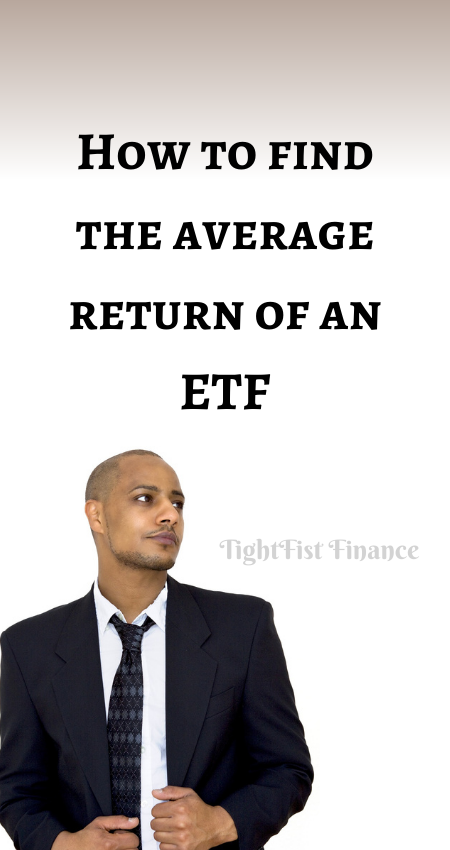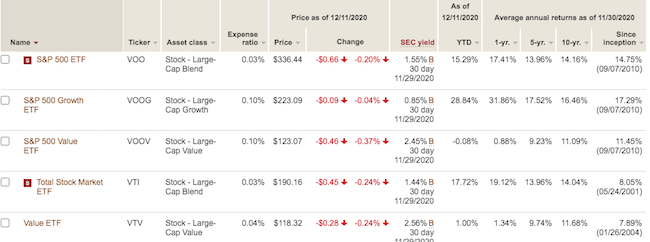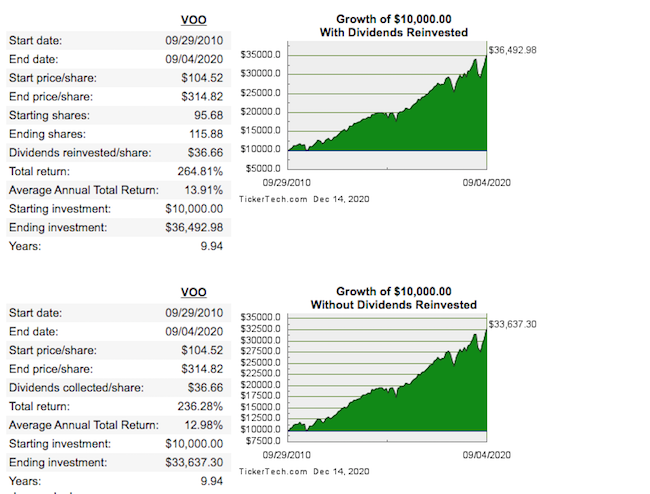How can you find the average return of an ETF?
To find the average return of an exchange traded fund, visit the ETF’s information page or use a DRIP calculator. The brokerage which offers the ETF provides performance history and investment information online. Alternatively, you can use a DRIP calculator to calculate return on investment over time.
Imagine, finding the best exchange traded fund with the great profit potential. You aren’t wasting your time investing in a fund which returns 4% per year.
Luckily for you, I’m going to show you how to find the average return of an ETF. I’ll even show you what a good return on investment is, so you can make an informed decision.

This article may contain affiliate links which pays a commission and supports this blog. Thank you for your support!
How is average annualized returns calculated?
Average annualized returns are the yearly returns of a fund averaged over time. A 10 year annualized return of 10% means the fund has an average return of 10% over 10 years. Average annualized returns are often calculated for 1, 5, and 10 years.
Let’s take a look at an example for how annualized returns are calculated.
| Year | Yearly Return |
| 2010 | 10% |
| 2011 | 13% |
| 2012 | -20% |
| 2013 | 33% |
| 2014 | 5% |
| 2015 | 8% |
| 2016 | -3% |
| 2017 | 12% |
| 2018 | 7% |
| 2019 | 8% |
As you can see, We have 10 years worth of returns. Please note that the returns are for example purposes only.
So what is the average 10 year annualized return?
10 year annual return = (10%+13%-20%+33%+5%+8%-3%+12%+7%+8%) ÷ 10 years
10 year annual return = 73% ÷ 10 years
10 year annual return = 7.3%
As you can see, the annualized return over a 10-year period is 7.3%. It simply means on average, the fund or stock will return 7.3%. However, there will be up years and down years.
A lot of people make the mistake of thinking the fund will always produce a 7.3% return every year. Unfortunately, that isn’t accurate because you can’t predict the yearly return. The stocks or ETFs will perform better some years and worse in other years.
Click to Tweet! Please Share!Click To TweetHow to find the average return of an ETF?
You can find the average return of an ETF by visiting the funds website. The fund manager will provide ETF information for potential investors to review which includes performance. Alternatively, you can use a DRIP calculator to calculate the returns yourself.
Visit the ETF performance page to find average return
Let’s assume you are wanting to find the average return of VOO, the Vanguard S&P 500 Index Fund. Doing a quick Google search, I can find a list of Vanguard ETFs, which includes VOO.

I can see the performance of the fund on the right side of the table. VOO has a 10 year annualized return of 14.16%. I can also see how VOO has been performing since inception, the last 5-years, and the last year.
Use a DRIP calculator to find average return
A DRIP calculator is a dividend reinvestment plan calculator. The calculator tells you what the rate of return is if you reinvested dividends or took them as a payment.
Dividend Channel has a good drip calculator.
Using the DRIP calculator, we can estimate the annualized returns of VOO for roughly the same time period. The DRIP calculator estimates the return of $10,000 over the 10 year time frame.

Should you have reinvested your dividends, your average annual total return would be 13.91%. Note, there is a slight change from 14.16% because of reporting dates. However, this is a very accurate calculator!
Someone who decided to take their dividend payments only receives an annual total return of 12.98%. When you don’t reinvest the dividends, you aren’t buying additional shares to make more dividends.
What is the typical average return of an ETF?
The benchmark for market returns is the S&P 500. Typically, the S&P 500 has returned an annualized return of 10% since inception. Therefore, the typical average return of an ETF is around 10%, but individual ETF performance varies depending on the index they are tracking.
You need to consider the purpose of the ETF before you start investing. Remember, you can always find the fund’s performance on the investment page.
An example of where you need to be careful is sector-specific exchange traded funds. A sector-specific fund tracks individual commodities like energy or real estate.
When you invest in a sector-specific ETF you are only investing in a small portion of the market. Therefore, your returns may be greater or less than the overall market.
For example, the Vanguard energy ETF (VDE) currently has a -3.42% return on investment for a 10 year period. VDE has performed horribly compared to the S&P 500 14.16% during the same time frame.
Now, let’s look at VGT or the Vanguard Information Technology ETF. VGT has a 10 year annualized return of 20.48%, which beats the S&P 500’s performance.
What is a good rate of return on an investment?
A good rate of return on investment is 10% to match the S&P 500 historical returns. When you are looking to invest, consider if your investment can beat a 10% return on investment. If your investment cannot beat a 10% ROI then your money would be better off in an S&P 500 Index Fund.
ETF investing is one of the most passive forms of investing. You can simply buy a share of an ETF and not have to touch it until years later.
It is best to make sure that your investments can beat the S&P 500. In other words, don’t buy a real estate deal that’s only going to return 5% on your money. You can get 10% ROI with an index fund, so why get less return for more work?
Click to Tweet! Please Share!Click To TweetSummary: How to find the average return of an ETF
As you can see, the average return of an ETF is the yearly performance divided by the time frame. A 10 year annualized return is the average of 10 years of performance. Do not make the mistake of thinking a 10% return is guaranteed every single year.
Remember, there will always be up years and down years. An average rate of return is simply just the average.
You can find an exchange traded funds performance by visiting the funds information page. If the fund is held by Vanguard, then look on Vanguard’s website. Alternatively, you can use a DRIP calculator to compare your overall returns between ETFs.
The average rate of return for the market is around 10% with the S&P 500 as the benchmark. Therefore, be very careful about investing in anything that doesn’t provide a 10% ROI or better.
